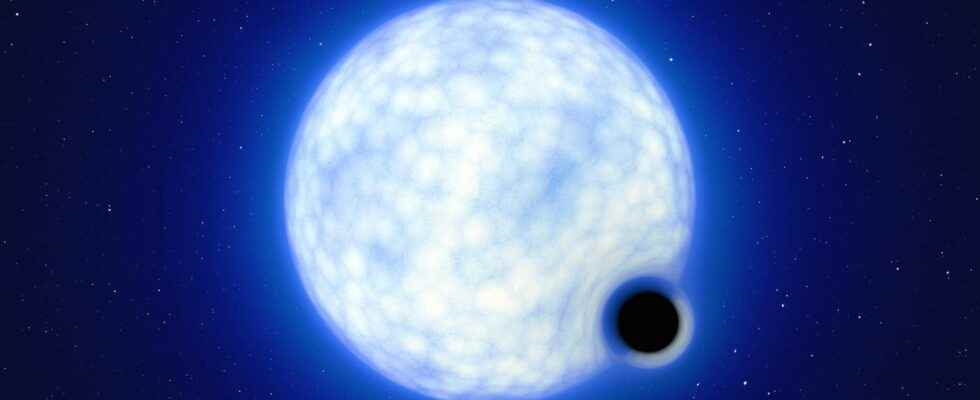Black holes have become commonplace in the media landscape in recent years and despite the enigmas that still surround them and which touch on very deep questions of physical theoretical, they are commonly considered in astrophysics and in cosmology. We even study their emissions ofgravitational waves in collisions with other stars relativistic compacts. Recently, we have even obtained with radio telescopes images of their surroundings betraying the existence of what is thought to be an event horizonwhich is the very definition of a black hole when it is a closed surface.
Admittedly, definitive proof of the existence of black holes still eludes us. but the doubts as to their presence in certain corners of the Milky Way and galaxies are increasingly difficult to justify. What contrast with the beginning of the 1960s when only a handful of visionaries, such John Wheelertook these solutions from the equations of the general relativity seriously, even Einstein didn’t.
The first candidates for the title of black holes were nevertheless flushed out during the 1970s, in the form of a binary system where a stellar black hole, i.e. produced by thecollapse gravity of a star probably at least 30 masses solar rays, also happened to be a powerful source of X-rays by accreting matter from its companion star.
This matter, while falling in spiral towards the black hole indeed forms a compact disc where viscous friction forces between the spirals of gas adjacent areas give off heat to the point of producing a bright hot plasma in the X-ray range.
Black holes are among the most opaque objects in the Universe. Fortunately, however, they are among the most attractive, and it is by their excessive power of attraction that we can detect them. Giant black holes are the most monstrous ogres in the cosmic zoo, but they are not weapons of mass destruction. The jets of matter they produce would have helped to ignite the first stars and form the first galaxies. Hubert Reeves and Jean-Pierre Luminet, specialists in contemporary cosmology, answer all your questions. To find out more, visit the site From the big bang to the living. © ECP Group, YouTube
However, we know that the majority of stars form binary systems, we must therefore expect that there are a certain number of these binaries X in the Milky Way. However, it is also possible that the distance of a stellar black hole from its companion star is such that no noticeable material transfer occurs. So no accretion disk and no X-ray emission, too, for example because the star has not yet become a red giant which has expanded to the point of overflowing what is called its Roche lobe, named after the mathematician and astronomer 19th century Frenche century.
The first emerged spike of a population of dormant black holes
This kind of stellar black hole is said to be ” sleeping and so far none had been detected. That has just changed thanks to an international team of astronomers who used the Flames instrument for their discovery (Fiber Large Array Multi Element Spectrograph) on the VLT of the’ESOas the researchers explain in an article published in Nature Astronomy.
To do this, they had to turn the gaze of the VLT towards the nebula of the Tarantula located in the Large Magellanic Cloud, a neighboring galaxy to ours. Six years of observations were necessary for the team led by Tomer Shenar, who began this research at KU Leuven in Belgium and who is now a Marie-Curie fellow at the University of Amsterdam, in the Netherlands.
The dormant black hole candidate has been dubbed VFTS 243. It contains at least nine times the mass of our Sun and revolves around a hot blue star weighing 25 times the mass of the Sun. Remarkably, it is not accompanied by noticeable traces of remains from an explosion of supernova (More precisely quasi-circular orbitand the kinematics of VFTS 243 imply that the collapse of the progenitor star into athe black hole was associated with little or no ejected matter) suggesting that, as thought, a gravitationally collapsing star can sometimes directly become a black hole without going through the supernova stage.
” The star that formed VFTS 243’s black hole appears to have collapsed entirely, with no signs of an earlier explosionexplains Tomer Shenar in an ESO statement in which he adds, evidence for this “direct collapse” scenario has emerged recently, but our study provides arguably one of the most direct indications. This has enormous implications for the origin of mergers black holes in the cosmos. »
To obtain a fairly accurate French translation, click on the white rectangle at the bottom right. The English subtitles should then appear. Then click on the nut to the right of the rectangle, then on “Subtitles” and finally on “Translate automatically”. Choose “French”. © European Southern Observatory (ESO)
Interested in what you just read?
